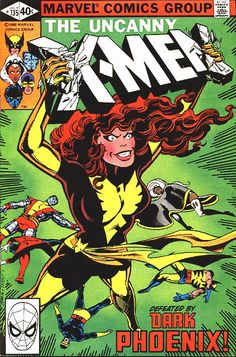
So welcome to the first of many posts celebrating the years of support from loyal followers of the House. We start with Kostas who initially gave me the idea of setting up a comic book club where one day my comics will live and anyone can come to read them. One day this will be the fate of my most precious collection and I cannot think of a better home for them. His choice was the Dark Phoenix Saga which I have enjoyed reading immensely, but was not an easy one to get through…it takes its place on the walls built by you all.
X-Men: The Dark Phoenix Saga

It is incredible to read a comic from the very beginning of the eighties when I were only a few months old. This is one of the most highly regarded X-Men comics and Chris Claremont and John Byrne are part of Marvel folklore. I purchased the graphic novel collection that featured the first appearances of Kitty Pride, Emma Frost and Dazzler, leading into the Hellfire club story and culminating in a Shi’ar finale. That is a great many characters in only nine issues but the seeds were sown early on with respect to the physic manipulation of Jean and the evolution of her powers. In fact it is interesting to reflect on how the story is put together because it is not like anything you will read now. The over-arching plot is all important and everything acts as data entry points feeding into an unorganised narrative folder. That is why this book is quite difficult to read and you have to take so many perspectives into account. This includes a third person narration, multiple individual character thought bubbles and repetitive set piece establishment. Clearly the serialised graphic novel form was not an option a few decades ago and so unless you owned previous issues, but you simply do not need to be told time and time again that Westchester was the home of the X-Men.

On the whole these aspects make for a clunky read but as the story progresses there are key moments that require due attention. Examples of this include the deterioration of Scott and Jean’s relationship and the detachment Xavier feels from his old team. Instead there are multiple action scenes and a wad of unnecessary character non-directed one liners. If you inspect more deeply you notice that quite often the X-Men seem to speak more about what they are doing to themselves and the reader. It is quite fascinating how the premise of first person narrative, telling the reader what you are doing takes precedent over showing it. It is a shame really because Byrne has some amazing moments in these issues but is often boxed into the multiple full bodied perspectives. When he is released you can truly appreciate the intricacies of expression when drawn close up. The skin creases provide texture but do not crowd the face and the shading fantastic, although sometimes an overused effect. The motions Byrne draws are so swift and fluid that you can truly appreciate the tumbling between Nightcrawler and Sebastian Shaw. In fact that momentum is maintained even during the rainfall of the Storm and Phoenix confrontation. There is a feeling that if you allowed him to take control over the exposition of the story, there would be less of a need for so much vocabulary. That sentiment is highlighted by the wondrous pages of the Dark Phoenix flying around space, where her power is realised in the ease in which she leaves Earths and flies into a star. The stars in the sky look incredible and there are delightful effects using the flamed bird as a representation of Jean’s power.

Despite the lack of clear focus in direction, the plot is well described and the pertinent aspects have apt clarity. Each hero and villain has a defined persona and power set, with few details omitted, particularly useful with respects to the Imperial Guard battle. It is wonderful to see the beginnings of characters that have become so well established in time. The power of Shaw, the creepy manipulation of Mastermind and the impact of Leland’s gravity altering ability is enjoyable to read. By far the most enlightening is witnessing Kitty Pryde and her innocent affection and devotion to the X-Men, especially as Byrne draws her face so bright eyed. The Dark Phoenix saga is etched onto the foundation stones of every comic fans love for the art form, not from just this book but the movies and animated series and you understand why. It may take nine issues for Jean to realise her own fallibility in controlling the Phoenix but it also takes that long to realise she cannot be separated from it. We may see every X-Man’s perspective but ultimately it is her own humanity that allows her to take responsibility for her own actions. The multitude of action sequences and rallying of the X-Men lead to this one moment where one of their own is too far gone. The righteousness and resilience of the X-Men will only lead to failure, even Jean tries to recapture her youth by wearing her old costume. The beauty of Claremont and Byrne’s story is that the most important decisions are the toughest, even when it comes to leaving the ones you love. See it doesn’t matter how many words you put on the page, or how the pictures tell the story, there are some ideas that come across because at their heart they are honest yet tragic. The death of Jean Grey will always be seminal to comic book culture because it devastated each and everyone of us, in whatever format we first experienced it. And it is those moments that comics struggle to replicate in the current age. So I place the Dark Phoenix Saga on the walls of the House with a nod to the way it used to be done.


